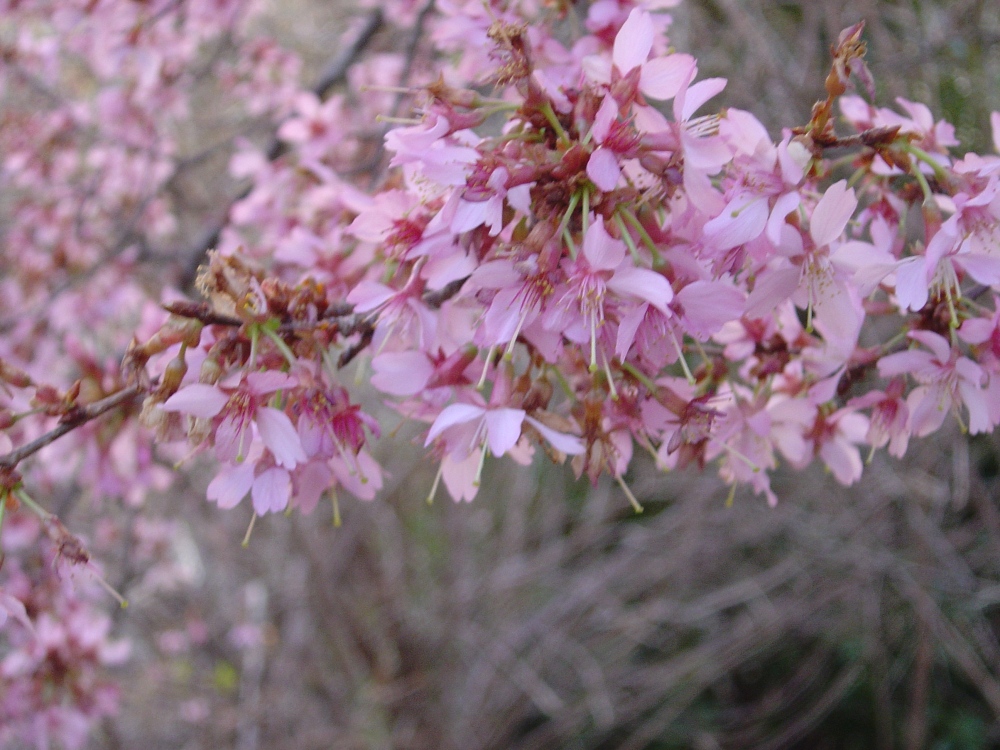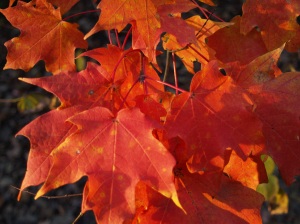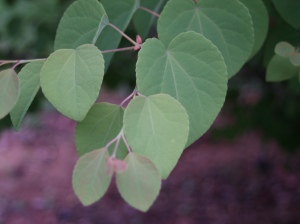Too often I see properties that have been overwhelmed by a single tree, so that branches block driveways or walkways and must be chopped annually to prevent structural damage. The fault is not with the tree, of course, but in lack of attention in making an appropriate selection years earlier. There is a wealth of information available in books and on the internet, and landscape designers and garden center professionals are willing to consult so that there should be little reason for planting a tree that will grow too large for a property.
The largest trees, and potentially most troublesome for smaller lots, are shade trees. Many of us grew up with maples and oaks (or poplars, elms, and willows), and when confronted with a treeless property and a blazing sun it is quite natural to consider these first. Before you rush to the garden center, stop for a moment and walk the area where you intend to plant. From the point where you will dig the hole take three to four paces in the direction of the house, or the driveway or walk. This is the width of many shade trees in only five years. Walk another three to four paces. This is ten years.
If you have bumped into the house, or walked halfway across the driveway, then a maple or oak is likely not to be an appropriate tree for this setting. I often use a two car garage to help imagine the width that a mature shade tree will grow to. If this is too large, then envision a one car garage. This is the size that many “small” trees grow to become. Some trees are stuck in the middle, such as many flowering cherries that grow only to thirty feet in height, but grow as broad as a maple.
If your pacing has caused you to reconsider your choice of trees then you are on your way to a well designed and functional landscape. Don’t be discouraged. There are plenty of superb choices for smaller properties, and many will grow surprisingly quickly and are quite beautiful. Below is guide (though not all-inclusive) for the size that you can expect trees to grow to in a landscape setting, which is generally a bit shorter than the mature height of a tree in a forest.
Most trees will grow nearly as wide as their height, though there are exceptions such as birch that are much more upright in habit. Some trees have a vase-like form, and so lower branches are more upright so they are less likely to cause a problem with driveways and walks. On the other hand, the branching of some trees becomes more horizontal or even pendulous with age, and these can cause problems that are not easily corrected. Beyond the approximate sizes listed below you should consult references that will detail the growth and form of trees that you are considering.
Large trees – 50 feet or taller
Maples (Acer) – fast growing, shallow rooted. tall growing except Japanese maples.
Oaks (Quercus) – long lived, hard wooded.
Ash (Fraxinus) – beware ash borers. Banned in some areas.
Poplars (Liriodendron) – soft wooded, very tall.
Beech (Fagus) – painfully slow growing, but ultimately a large stately tree.
Birch (Betula) – more upright form allows planting in smaller areas.
Locust (Gleditsia) – more spreading head, filtered, not heavy shade.
Sweet Gum (Liquidambar) – watch out for the seeds.
Evergreen magnolias – usually retain lower branches so that they occupy more space at ground level.
Sycamore/ London Planetree (Platanus) – pollution resistant, great for commercial parking lots.
Bald Cypress (Taxodium) – unique deciduous conifer. Often found in damp areas.
Dawn Redwood (Metasequoia) – a prehistoric deciduous conifer. Fast growing.
Linden (Tilia) – slower growing, but Japanese beetles love them.
Willow (Salix) – many are more broad than tall, short-lived, weak wooded.
Zelkova – some varieties have upright branching.
Medium/ tall trees – 30-50 feet tall
Cherries (Prunus) – the tallest types reach thirty feet, but wider than tall.
Yellowwood (Cladrastis) – unique blooms and foliage, but soft wooded.
Black Gum (Nyssa) – wonderful autumn foliage.
Pear (Pyrus) – research problems with splitting before buying.
Hornbeam (Carpinus) – beware the fastigiate types that spread as they age.
Goldenrain Tree (Koelreuteria) – coarse textured, seeds germinate everywhere, but beautiful.
Katsura (Cercidiphyllum) – Beautiful, heart-shaped foliage. An outstanding selection.
Silverbell (Halesia) – dangling white blooms mid-spring.
Medium trees 20-30 feet tall
Serviceberry (Amelanchier) – often multi trunked, spring blooms.
Hawthorn (Crataegus) upright, often clumping form
Dogwood (Cornus) – most grow nearly as wide as tall. Native dogwoods, Chinese, and hybrids are unsurpassed small flowering trees.
Redbud (Cercis) – more spreading, wider than tall. Many forms, superb trees.
Japanese maples (Acer palmatum) – Bloodgood and other upright growers to 25 feet tall. Incredible leaf form and color.
Crapemyrtle (Lagerstroemia) – some over 20 feet, others under but most have upright form. Long lasting summer blooms, autumn foliage color, and peeling bark.
Magnolias – deciduous types – there are upright and wide spreading, almost shrub-like forms.
Stewartia – perhaps will grow taller in someone else’s lifetime. Slow, but a magnificent flowering tree.
Sourwood (Oxydendrum) – very slow growing, unique lily-of-the-valley blooms and great autumn foliage.
Small trees – under 20 feet
Plum (Prunus) – purple leafed, but Japanese beetles love them.
Crapemyrtle (Lagerstroemia) – many varieties grow 10-16 feet tall, and some below 10 feet. Others are shrubs.
Snowbell (Styrax) – rounded form, covered in small white or pink blooms in early summer.
Crabapple (Malus) – be certain to select disease resistant types.
Fringetree (Chionanthus) – often multi-trunked. Covered in fringe-like white blooms in early summer.
Goldenchain Tree (Laburnum) – Beautiful blooms, but resents heat and humidity.
Japanese maples (Acer palmatum, japonicum, and a few others lumped into the broader category of Japanese maple) – pendulous forms often remain under ten feet tall, but grow as wide or wider than tall.
Please forgive my omissions. There are many other wonderful trees, but I have not included them because they are not as common. If you know of a tree that’s not included then you are likely to know enough about it that you don’t need this brief reference. In my garden I grow Franklinia, Seven Son Tree, a deciduous Big Leaf magnolia that grows to a hundred feet (at least), and a variety of weeping and dwarf trees that will grow no taller than ten feet. I encourage you to explore less common trees, in particular those with unique foliage or blooms that are appropriate for smaller properties. Just because a lot has space to contain a large growing shade tree doesn’t mean that several (or many) smaller trees are not a better choice.
I hope that this brief listing of deciduous trees is useful, but evergreens are misused just as often. I advise the same research in determining mature sizes so that you are not paying for expensive tree surgery a few years from now to make up for mistakes made today.
Great article on choosing the right tree. I wish I had thought about this 20 years ago.
Great Article. I am considering the Black Gum & Oaks now thanks to this article. Would you suggest mixing a couple of Black Gum & Oak trees with Greenleaf Hollies to create a woodland setting screen effect? We live on a busy road with a large lot (2 acres) and would like a forest like screen that is not a row of green like the Leyland Cypress that everyone seems to like to plant.
I prefer a mixed planting of deciduous trees and evergreens. Black gums and oaks will work well with the American holly, but I would also consider mixing in some flowering understory trees, such as dogwoods or redbuds. The lower branching of these provides a more effective screen once the taller trees have grown.
Avoid planting in straight lines, or in an obvious pattern such as a staggered row and the appearance will be much more pleasing. Also, if the pattern is irregular and a tree is lost to a vehicle accident the missing tree will hardly be noticed.
My parent’s have several black gums in their backyard garden walkway, paired up with the numerous bird feeders and wells they have, they match up gorgeously!
-Carlos Hernandez